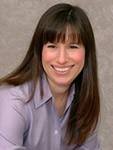The question really involves two questions:
1. Must one have a shank bone on the Seder Plate in the first place? (This is a question not just for dairy seders, but also for vegans)
2. If one were to have a shank bone, how would one avoid the mixing of meat and milk with the dairy served at the seder?
Regarding the first question, many vegans cite the Talmud in Pesachim 114b to claim that one may use a roasted beet on the Seder Plate instead of a shank bone. The Talmud there states that the following foods should be brought before the leader of the seder: charoset, lettuce (marror) and two cooked items. The Talmud asks what are the two cooked items? It answers its question saying beets and rice (there is then a discussion about rice on Pesach). Rashi comments that all the more so two pieces of meat would work.
Since in this age, after the destruction of the Temple, we do not eat roasted lamb in the manner the Passover offering was eaten, and there is no requirement to eat meat at all, it is certainly permissible to use the roasted beet on the Seder Plate instead of the Shank Bone.
The question of whether we will be obligated to eat the Passover offering again when the Temple is rebuilt is an oft debated one. Most Rabbis assume that we will. Others argue (often citing Rav Kook) that there will be no animal sacrifices in the times of the Messiah as animals will have reconciled with humans and attained a higher spiritual living. Still others say that all animal sacrifices will not exist with the exception of the Passover offering as that is the only one specifically mandated in the Torah that everyone bring and eat.
Therefore, the placement of the shankbone on a seder plate even at a dairy meal might invite such questions. And what is the Seder for, if not for discussing our own ideas about redemption and what the future might hold in store for us.
If for that reason, one chooses to use a shankbone, the second question comes into play.
Jewish law allows for two people to eat at the same table where one is eating meat and one eating dairy, provided that they place some type of a “heker,” an acknowledgement to keep them separate. The acknowledgement might come in the form of different place mats, a divider on the table, etc.
Presumably one could then put some acknowledgement on the table to indicate that the seder plate is meat and everything else is dairy. However, this would still be a problem if the leader of the seder eats the seder items (karpas, marror, and charoset) from the seder plate and will be eating dairy as well.
I would, therefore, suggest that if one does have a shankbone at a dairy meal, to first place some acknowledgement on the table that the seder plate is meat (and have the seder plate on some sort of place mat), but then also to remove the seder plate from the table after the necessary seder foods have been eaten and before any dairy is brought to the table.









